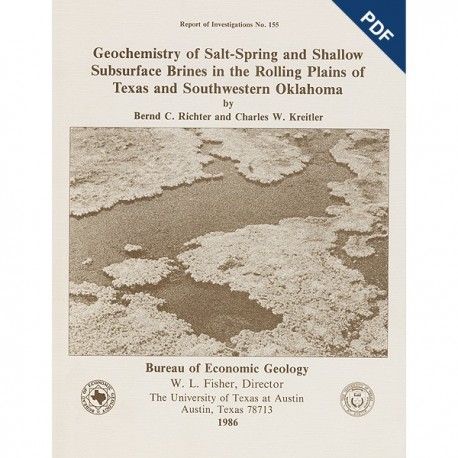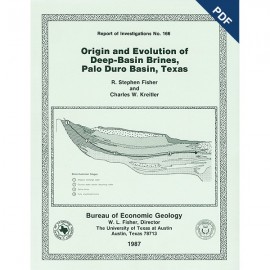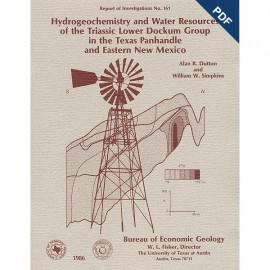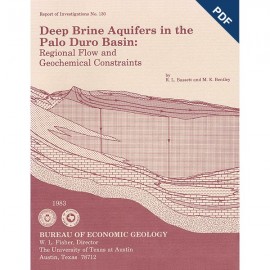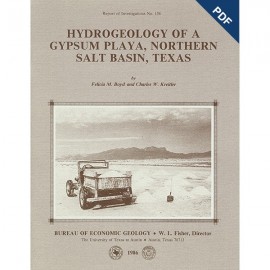Reports of Investigations
-
Books & Reports
- Reports of Investigations
- Guidebooks
- Udden Series
- Geological Circulars
- Down To Earth
- Atlases of Major Oil and Gas Reservoirs
- Texas Memorial Museum Publications
- Environmental Geologic Atlas of the Texas Coastal Zone
- Mineral Resource Circulars
- Other Reports
- Seminars and Workshops
- Handbooks
- Submerged Lands of Texas
- Symposia
- Annual Reports
- Open File Reports
-
Maps & Cross Sections
- Thematic Maps
- Miscellaneous Maps, Charts & Sections
- Geologic Atlas of Texas
- STATEMAP Project Maps
- Geologic Quadrangle Maps
- Cross Sections
- Highway Geology Map
- Energy and Mineral Resource Maps
- Shoreline Change and Other Posters
- Wilcox Group, East Texas, Geological / Hydrological Folios
- Bouguer Gravity Atlas of Texas
- River Basin Regional Studies
- Featured Maps
- Posters
- Teachers & the Public
-
Geological Society Publications
- Gulf Coast Association of Geological Societies
- Alabama Geological Society
- Austin Geological Society
- Corpus Christi Geological Society
- Houston Geological Society
- Lafayette Geological Society
- Mississippi Geological Society
- New Orleans Geological Society
- South Texas Geological Society
- GCS SEPM Publications
- Historic BEG & UT Series
Geochemistry of Salt-Spring and Shallow Subsurface Brines in the Rolling Plains of Texas and Southwestern Oklahoma
RI0155D
For a print version: RI0155.
RI0155D. Geochemistry of Salt-Spring and Shallow Subsurface Brines in the Rolling Plains of Texas and Southwestern Oklahoma, by B. C. Richter and C. W. Kreitler. 47 p., 25 figs., 6 tables, 1 appendix, 1986. doi.org/10.23867/RI0155D. Downloadable PDF.
To purchase this publication in book format, please order RI0155.
ABSTRACT
Numerous salt-emission areas exist within the Permian outcrop in the Rolling Plains of Texas and southwestern Oklahoma. Sodium chloride waters underlie the area at relatively shallow depths, discharge from salt springs and salt seeps, and greatly impair the quality of ground and surface waters. This study distinguishes between brine derived from dissolution of halite by fresh, locally recharged ground water in a shallow ground-water system and brine derived from deep-basin brine aquifers. Halite dissolution brines typically have molar Na/Cl ratios of about 1, and Br/C and I/Cl weight ratios of less than 4 x 10-4 and less than 1 x 10-5, respectively. Deep-basin brines, in contrast, exhibit ratios of less than 1, greater than 2.5 x 10-3, and greater than 1 x 10-3, respectively.
Three groups of brines in the Rolling Plains can be distinguished according to these ratios: (I) halite-dissolution brine, found in samples from most salt springs and test holes in the north and west; (2) brine from deep-basin aquifers, evident in the shallow subsurface (30 to 100 ft or 9 to 30 m) in the south; and (3) brine exhibiting characteristics of both halite-dissolution and deep-basin brines, suggesting mixing. Other chemical constituents (Ca, Mg, and K) support this grouping of the brine data as well as our interpretation of different brine origins.
The isotopic composition (δ18O and δD) of the salt springs indicates a local meteoric origin for the halite-dissolution brines. Some brine samples from the shallow subsurface in the southeast plot on a line that includes deep-basin brine values and meteoric-water values as end points, suggesting dilution of deep-basin brine by meteoric ground water. The presence of deep-basin brine near land surface in the study area was not recognized in previous studies.
Keywords: Brazos River, brines, geochemistry, isotopes, Midland Basin, nuclear waste, Palo Duro Basin, Red River, Rolling Plains, springs, Texas
CONTENTS
ABSTRACT
INTRODUCTION
Purpose and scope
Previous work
Methodology
HYDROGEOLOGIC FRAMEWORK
Physiography and climate
Geologic setting
Lithology and depositional environments of principal hydrogeologic units
Pennsylvanian to Lower Permian marine section
Middle and Upper Permian evaporite section
Post-Permian section
Permian salt deposits
Ground-water flow
Salt-discharge areas
Red River basin
Salt Fork of the Brazos River
WATER CHEMISTRY
Halite-dissolution brine versus deep-basin brine
Hydrochemical facies
Data differentiation
Isotopic composition
Geographic distribution of brine types
SUMMARY AND CONCLUSIONS
ACKNOWLEDGMENTS
REFERENCES
APPENDIX: salt-discharge areas
Red River basin
Salt Fork of the Brazos River
Figures
1. Brine-discharge areas in the Rolling Plains of North-Central Texas and southwestern Oklahoma
2. Structural elements of the Texas Panhandle
3. East-west cross section illustrating depositional systems in the Palo Duro Basin
4. Geologic map of the study area
5. Limits of salt strata in the Palo Duro Basin
6. Hydrologic units and apparent ground-water flow lines, Palo Duro Basin
7. Ground-water-flow model and mechanism of salt dissolution within the study area
8. Location of salt springs and test holes
9. Geochemical facies of salt-spring and shallow subsurface brines in the Rolling Plains of Texas and southwestern Oklahoma
10. Ratios of mNa/mCI and gBr/gCl versus mCI in deep-basin brines from the Palo Duro and Midland Basins
11. Ratios of mNa/mCI versus Cl of salt-spring and shallow subsurface brines in the Rolling Plains of Texas and southwestern Oklahoma
12. Ratios of gBr/gCl versus Cl of salt-spring and shallow subsurface brines in the Rolling Plains of Texas and southwestern Oklahoma
13. Major cation distribution in groups A, B, and C, and in deep-basin brines from the Palo Duro and Midland Basins
14. Magnesium versus chloride concentrations
15. Ratios of I/Cl versus Cl concentrations
16. Calcium versus chloride concentrations
17. Potassium versus chloride concentrations
18. Variation in calcium concentrations with sulfate and chloride concentrations, Group A brines
19. Molar ratios of (mCa + mMg)/SO4 versus mNa/mCl
20. Variation in mCa/mMg ratios in Group C brines and deep-basin brines from the Palo Duro and Midland Basins
21. Plot of δD and δ18O for shallow, fresh ground water from municipal wells in New Mexico and the Texas Panhandle, for salt springs and test-hole samples from North Croton Creek, and for deep-basin brines from the Palo Duro Basin
22. Plot of δ18O versus depth for waters at the North Croton Creek area
23. Plot of chloride concentration versus depth in test holes at the North Croton Creek area
24. Geographic distribution of samples according to brine type
25. Plot of gBr/gCl ratios versus depth for four salt-emission areas, Jonah/ Salt Creek, Middle Pease River, North Croton Creek, and Haystack/Dove/Croton Creek
Figure A-1. Geologic cross section, Estelline Springs and Jonah Creek
Tables
1. Relationship between generalized stratigraphic and hydrogeologic units
2. Compilation of estimates of salt loads discharged at major brine-discharge areas
3. Chemical analyses, Group A brines
4. Chemical analyses, Group B brines
5. Chemical analyses, Group C brines
6. Chemical analyses of deep-basin brines, Palo Duro and Midland Basins
Citation
Richter, B. C., and Kreitler, C. W., 1986, Geochemistry of Salt-Spring and Shallow Subsurface Brines in the Rolling Plains of Texas and Southwestern Oklahoma: The University of Texas at Austin, Bureau of Economic Geology, Report of Investigations No. 155, 47 p.
